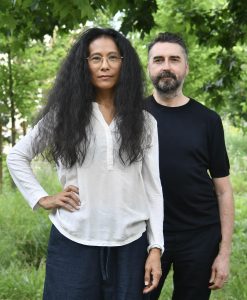SANDRA GAMARRA PRESENTS “MIGRANT ART GALLERY” AT THE SPANISH PAVILION DURING THE 60TH VENICE BIENNALE

The Ministry of Foreign Affairs, European Union and Cooperation of Spain, through the Spanish Agency for International Development and Cooperation (AECID), in collaboration with Acción Cultural Española (AC/E), presents further details of the Pinacoteca Migrante/ Migrant Art Gallery, developed by Sandra Gamarra Heshiki for the Spanish Pavilion in the 60th International Art Exhibition of La Biennale di Venezia 2024. As the first migrant artist chosen to represent Spain, Gamarra Heshiki uses the museum as the main axis of the project as a narrator of great stories, whose methods of representation have been assumed to be “universal”. Pinacoteca Migrante/ Migrant Art Gallery is curated by Agustín Pérez Rubio.
Gamarra Heshiki will transform the Spanish Pavilion into a historic gallery of Western art where the notion of “migration”, in its many facets, will be the protagonist. The Western concept of the art gallery, which was exported to the former colonies, is inverted, exposing a series of historically silenced narratives. Thus, Pinacoteca Migrante/ Migrant Art Gallery responds to accessibility, diversity and sustainability within an institutional framework and inserts contemporary contexts in relation to racism, migration or extractivism. The protagonists are the migrants, both human and not: living organisms, plants and raw materials that often made the round trip by force.
The extensive research carried out by Gamarra Heshiki will also be reflected in a series of new works whose starting point are paintings, from the time of the Empire to the Enlightenment, from art collections and museums throughout Spain. These works interfere with the lack of decolonial narratives in museums and will analyze the biased representations between colonizers and colonized. Sociology, politics, art history and biology are intertwined in this research.
The central open space of the Spanish Pavilion will be occupied by the Migrant Garden, which is presented as a counter-narrative to the historical museum. This garden is inhabited by twelve monuments that remember key characters from colonised communities. On the reverse side of each sculpture, you can read about the figures or cultures they refer to.
The first five rooms, which will lead to the garden, will feature different themes from classical painting traditions such as landscape, still life, scientific illustration, and portraiture, among others, viewing them as tools with political agendas that promote monolithic constructions of nation states. For Gamarra Heshiki, the narrative of the project elaborates a continuous cycle between construction and deterioration. For this reason, these paintings are presented as sketches, finished works, or in a state of permanent restoration, as a metaphor for the open colonial wound.
The first room, titled Virgin Land, will deal with landscape paintings that belong to different Spanish museums and refer to the current Spanish territory, as well as the former colonies of Latin America, the Philippines and North Africa. Quotes from writers, ecofeminist thinkers or intellectuals will be superimposed on each painting.
It will be followed by the room titled Cabinet of Extinction, which will link colonialism with extractivism by showing the “treasures” of European botanical expeditions during the 18th and 19th centuries. Gamarra Heshiki will paint some of the facsimiles of the illustrations from the “Royal Botanical Expedition to the Kingdom of New Granada” including human hands as part of the same interdependent survival system.
The space entitled Cabinet of Illustrated Racism will present the way in which anthropology and science were used as tools of racial discrimination. It will include illustrations and objects labeled “scientific” at the time, to support the idea of classification and impose the Western will for hierarchical superiority over the Global South.
The room titled Mestiza Masks will delve into the colonial practices of portraiture, which were conceived as time capsules that seek to immortalize political and social norms. Each work will expose the way in which societies accept or marginalize their subjects. Consequently, it will displace gender divisions to question the patriarchal structure as a naturalized norm.
The central gallery, titled Altarpiece of Dying Nature, will show still life painting as a genre that synthesizes the themes of the previous rooms and, in turn, shows the ways in which we inhabit the world. This great polyptych will reveal notions of accumulation and ostentation that are promoted by Western society.
Finally, the Migrant Garden will be inhabited by painted copies of monuments, as well as representations of alien or invasive plants. This patio is presented as a place of restitution of works not made visible in the metropolis. Those represented here have made a symbolic journey, like alien plants, they have found soil to stay. It presents the view that the alteration of ecosystems should be valued and measured from a perspective in which all species live harmoniously without hierarchies.
Pinacoteca Migrante/ Migrant Art Gallery aims to provide a model that updates protocols in the accessibility, diversity and sustainability of institutions, dismantling the structures that perpetuate the hegemonic hierarchies of colonialism.
On the occasion of this project, the AECID will publish a 240-page publication edited by Agustín Pérez Rubio with Antoine Henry Jonquères as editorial advisor and Laoficina as editorial coordinator. The work will include texts by Françoise Vergès, Yayo Herrero, Gabriela Wiener, Yeison F. García López, Neferti X. M. Tadiar and María Berríos, as well as a conversation between the artist, the curator and Esther Gabara. The design will be carried out by Eugenio Simó’s graphic studio, and the publication will be distributed internationally by Walter Köning Books.